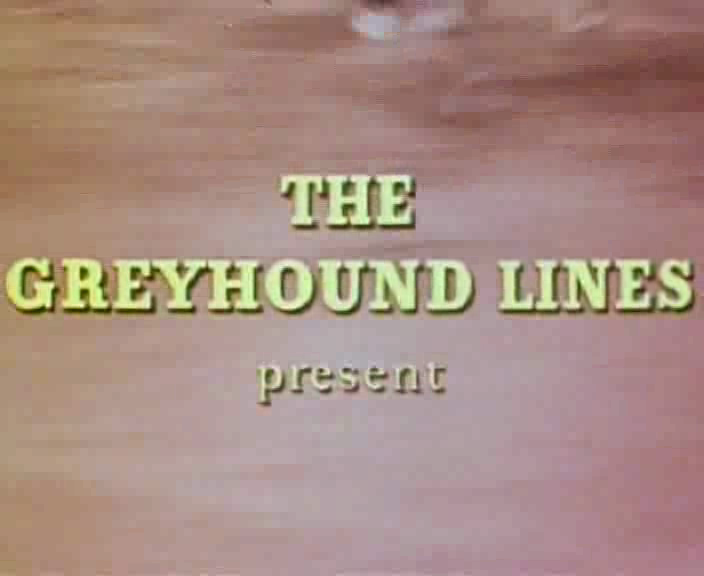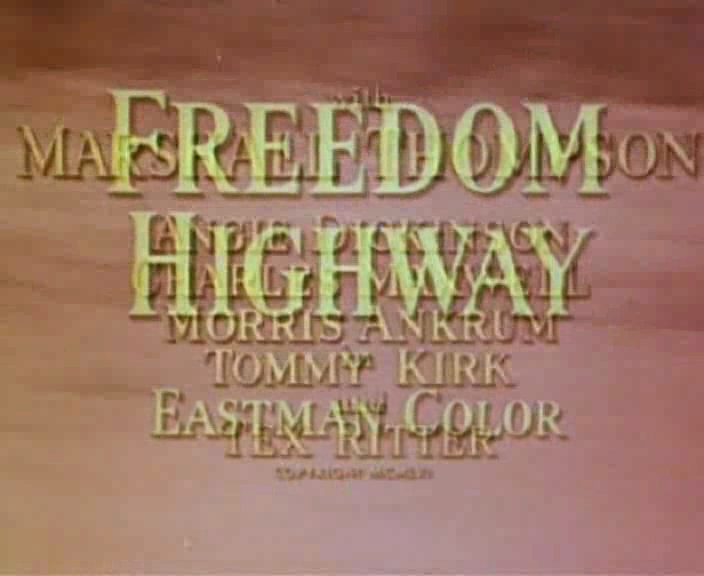Freedom Highway (1956)
Info from archive.org:
Producer:
Fairbanks (Jerry) Productions
Sponsor: Greyhound Lines
Creative Commons license:
Public Domain
Description (from archive.org):
A Greyhound bus transports us through the landscape of American mythology.
Directed by Harold Schuster.
Director of Photography:
Jerry Fairbanks.
Screenplay:
Charles L. Tedford,
Leo S. Rosencrans.
Film Editor:
Milton Kleinberg.
Art Director:
Theobold Holsopple.
Production Supervisor:
John McKennon.
Musical Supervision:
Edward Paul.
Assistant Director:
Robert Scrivner.
With Marshall Thompson (Mysterious Stranger); Tommy Kirk (Jimmy Rollins); Morris Ankrum (Fred Schroder); Angie Dickinson (Mary); Charles Maxwell (Bill Roberts) and Tex Ritter as himself.
Winner of the Freedoms Foundation Special Award.
Review (from archive.org):
Travelogues set landscapes in motion, and Freedom Highway exploits the roadside panorama as an excuse to celebrate American mythologies. Hanging in the sky as if they were ghosts, patriots, warriors and the myths they exemplify -- the frontier, national independence and manifest destiny -- come to life at key points along the transcontinental route.
Although Americans are widely considered to be a practical, well-grounded people with their eyes on the future, Freedom Highway shows a nation in need of spiritual and patriotic renewal, and this renewal is to be sought in our past. The bus -- the most democratic means of transportation, a great equalizer between people, is the perfect vehicle for the freedom highway, a big metal box on wheels in which the faithless ride and rediscover their lost belief. The busbound journey through space will become a journey through time as great moments and personalities in U.S. history are recreated.
Throughout this century, but especially during the Cold War era, the American landscape has been dominated by visions of past struggles and victories. A look at the familiar images in the supplement, all drawn from vintage road maps, testifies to the familiarity of these visions but also to their more disturbing nature. Most of these images, and most of the images in Freedom Highway, celebrate European exploration, settlement and territorial expansion together with Manifest Destiny, their theoretical inspiration. The Boy Scout, explorer of state parks, vacant lots and fragments of suburban forest, becomes the wide-eyed observer of this mix of present and past. Some souls might be disturbed by this one-sided mythology, like those of Native Americans or those that died to make this expansion possible, but Freedom Highway venerates the past with pride.
"Push 'em through!" shouts a Civil War-era officer leading a wagon train through Native American land, and an intense battle begins where later Greyhound buses will roll. So begins Freedom Highway. In the United States Magazine and Democratic Review (July 1845), John L. O'Sullivan wrote of "our manifest destiny to overspread the continent allotted by Providence for the free development of our yearly multiplying millions." O'Sullivan was writing about the annexation of Texas, which was admitted as a state that year, and his expression "manifest destiny" would later be invoked in many other contexts, especially by those who, later in the century, sought to annex Cuba. "Freedom," as in Freedom Highway, and manifest destiny are closely linked, and manifest destiny is itself linked to road building, to breaking through, to "fighting for our right of way," in the words of the General Motors film Give Yourself the Green Light (1954). Our national obsession with building highways and personalized individual transportation is embodied in our view of freedom as an open road stretching out into the distance.
This entertaining "story of America," as endless as a cross-country bus ride, places an unusual group of travelers on a long-haul Greyhound bus. Fred Schroder, embittered by the death of his son in Korea, is riding to Washington to accept a posthumous Congressional Medal of Honor on the son's behalf. Jimmy Rollins, the Scout, is heading to Washington for his first Jamboree. Love interest is supplied by Mary (a young Angie Dickinson) and Bill Roberts, a basketball star on the make. Tex Ritter, playing himself, takes a short ride on the bus as it passes through Texas, singing about the Alamo and the "freedom road." Most important of all, a black-suited mysterious stranger appears, as if from nowhere, to transform the outlook of the passengers, who include us, the audience. With all the subtlety and depth of a Reader's Digest article, each passenger will do their bit to squeeze patriotic meaning out of the landscape. And yet there's nothing particularly American in the way this film works; one wants to find the Soviet equivalent, which probably is set on the Trans-Siberian Express.
DOWNLOAD (Divx as multi-part rar-file, each part around 100 MB):
PART 1
PART 2
PART 3
PART 4
NOTE: Tex Ritter sings the title song and "Remember the Alamo".




Keine Kommentare:
Kommentar veröffentlichen